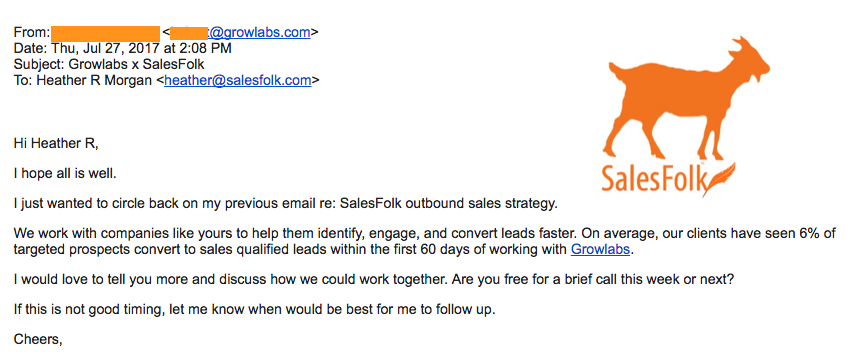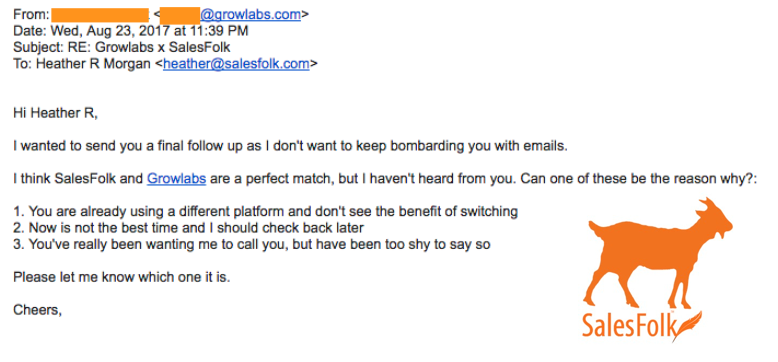When your leads lists are hundreds, or even thousands, strong, it’s impossible to research and address the specific business challenges of every single contact. After all, nobody has the time or energy for that many people, and the more people you can tailor your message to, the better, right?
Wrong.
When you need to address a large audience, it’s easy to fall into the trap of thinking generic is better, whether it’s with the benefits you mention or the sentences you write. In reality, if you don’t infuse every word and sentence with value for the reader, you risk producing an email that’s so bland that nobody will bother reading it.
Unfortunately, Growlabs, an outsourced lead generation firm, does just that in this cold email:
More than 75% of the email is dedicated to pleasantries, a reference to a previous email I may not have read, and a lengthy, very passively phrased request for a call. It’s completely void of persuasiveness and lacking in specifics regarding what their company can do for me.
If this is what their own sales prospecting emails look like, I can only imagine what they must be sending on behalf of their clients.
Let’s take a look at another email they sent me:
The campaign continues with another blandly written email with a vague subject line (“Fit”) that does nothing to entice or encourage me to get in touch with them. Not to mention they screwed up my name in their mail merge, an obvious sign that the email was mass and that they didn’t spend any time to clean up their contact data. If they can’t write (or send) a good, compelling email, how good will they be at setting appointments with quality leads for my company?
Now let’s get to the last email in their boring campaign, a generic break up message asking me why I haven’t gotten in touch with them. They mention how Salesfolk and Growlabs are a “perfect match,” but don’t give any reasons why.
It’s ironic that some of the worst cold emails I see usually come from outsourced lead generation firms, which are to be trusted with sending emails to generate sales meetings with qualified leads on behalf of their clients. But, given the fact that many of these companies try to substitute volume with sending quality, targeted messages, this really isn’t so surprising.
Here are four ways Growlabs could have improved their generic email templates and probably gotten many more responses:
- Open with a line that sparks curiosity.
Instead of adding value from the start, the email’s sender goes for the standard greeting of people everywhere who aren’t sure what to say: “I hope all is well.” Pleasantries like this take up valuable real estate in your email, but add no value whatsoever. Instead, hook your prospect with a compelling question about their business, or provide them with an interesting statistic about their industry they might not be aware of.
- Focus on new info, not what you already said.
Referring to a previous email or reiterating a point from a past email isn’t an effective way to appeal to any audience. If they read your last email, repeating the same information probably won’t make them respond; if they didn’t read it, the information probably wasn’t compelling to begin with. Each email in the sequence should contain a fresh, new value proposition for your prospect. - Be specific about your accomplishments.
Generic language like, “We’ve worked with companies like yours…” is a huge red flag that signals the sender knows nothing about me or my business. Instead of shooting in the dark, as the email above does, think about who your audience is and come up with some past clients that actually are similar. Then explain the results you’ve gotten: “We helped sales teams at X, Y, and Z double their number of sales appointments in only three months.” - Make it clear that a follow-up call will offer further value.
Banish generic language from your call to action. In place of it, explain to your prospect exactly what value they’ll gain from spending some time with you on the phone. This could be a new idea to help them double their conversion rates, or you could reiterate your value proposition in a new and unique way. Once they accept, having that context can help helps give you a place to start the conversation.
Have bad cold emails in your inbox? Send them to us!
Help us fight the thoughtless spammers, one crappy cold email at a time by sending us the worst cold emails you’ve ever received. We’ll put them up anonymously on the “Hall of Shame,” and shoot you an email when they go live.
Please send all submissions to “[email protected].” (And feel free to suggest what you want to nominate the bad cold email for!)




